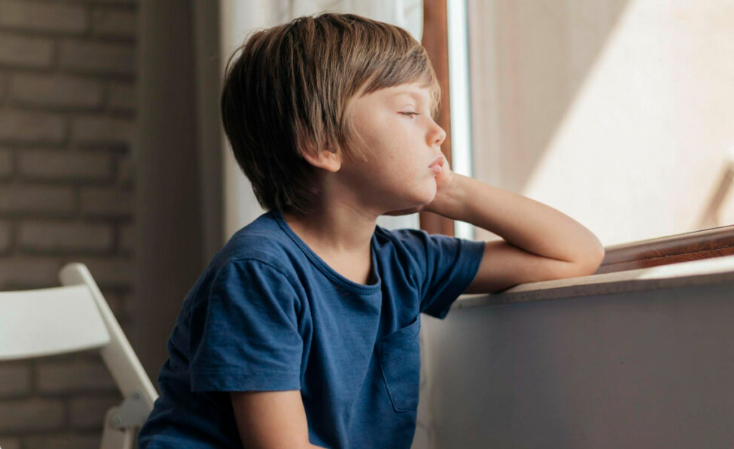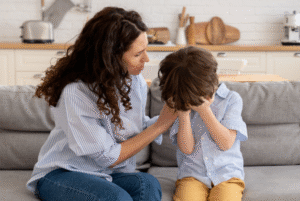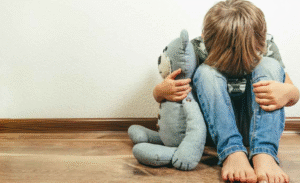How to Comfort a Child with Anxiety: Proven Ways to Soothe Their Worries
How can children be consoled when they are anxious? In this article, discover 10 easy and valuable tips that will assist you in offering comfort and emotional support to your anxious child.
“Did you know that 1 in every 8 children has anxiety?”
Sometimes childhood’s little fears appear so vast that they disturb the parents’ hearts. Pressure at school, fear of encountering new faces, or nighttime loneliness—all of these can be the cause of anxiety for a small child.
During those moments, the largest task of a father or mother is to offer comfort to their child. So, how do you comfort an anxious child? In this article, you will discover 10 tried and tested strategies that will calm your child. Let us come together and convert those nervous moments into a healing moment
What is childhood anxiety, and how does it manifest 
Childhood anxiety means that children are repeatedly tense and anxious about something without any clear reason. This may not be just a one-time thing that children see emotionally, but it may become a pattern. Children react to the same thing repeatedly through anxiety. Children are mostly worried about meeting people or being separated from them. This can affect their daily behavior, sleep, and mood.
Common triggers for anxious behavior
There can be many factors that trigger anxiety in children, such as:
-School pressure or exams
-Meeting a new place or new people
-Separation anxiety – being away from mom and dad
-A traumatic experience, such as an accident, death, or too many teeth
Differences between occasional worry and an anxiety disorder
Sometimes a little bit of anxiety can be seen in children, like when going to school or taking a test. All this is normal, which every child cannot experience, and there is no problem with it.
But if you feel that your child is very scared every day and is afraid to perform normal activities, his sleep is disturbed, or physical symptoms are appearing like stomach pain, headache, if this happens repeatedly, then you should consult a doctor. It can be a case of anxiety.
When to seek professional help
If you feel that your child is very scared every day and is afraid to perform normal activities, his sleep is disturbed, or physical symptoms are appearing like stomach pain, headache, if this happens repeatedly, then you should consult a doctor. It can be a case of anxiety.
When to seek professional help. If the child’s daily worries are creating problems in his normal lifestyle, such as not knowing anyone, not studying, not playing with other children, then you should make him understand and talk to a psychologist or counselor. Early intervention makes a lot of difference, and with therapy or counseling, the child is able to understand his emotions better and manage them.
1. Create a Safe and Calming Environment 
1. The magic of quiet, clutter-free space
When children are worried or have anxiety, the area around them matters a lot. For example, if their room is clean and there is positivity in their room, such as the things they like, this will relax the children a lot and make them feel comfortable. For example, if their favourite colours are in their room and they have their favourite toys, they feel good. There should be minimal distraction in the room so that they feel secure.
2. Use of soft lighting and sensory tools
If there is a bright light in the room or any triggering colour, then their anxiety will be reduced. There is a high chance of getting triggered. So keep the color of their room soft and light so that I feel comfortable, and there will be a cozy and secure feeling around them.
Additionally, sensory devices such as fidget toys, stress balls, or weighted blankets also help to calm kids. These devices level their sensory system and make them feel stable. If your kid feels relaxed with any of these, you can integrate them into their daily schedule.
3. Create a Soothing Routine
Routine serves as a stabilizer for anxious children. If they are aware of how their day will be, what will be done, and when, naturally, their level of anxiety will come down. A small bedtime routine, followed daily, like listening to a story, dinner at a specific time, and soothing music, before sleeping at night, makes them feel emotionally secure. This routine provides a predictable atmosphere for them in which there are fewer surprises, which is reassuring for them.
2. Use Reassuring and Validating Language
It is very important to be able to comprehend children’s feelings and comfort them properly, particularly if they are anxious. You can provide a great deal of comfort by merely adjusting the tone and words used while speaking to them slightly.
Things not to say (such as “don’t worry”)
Occasionally, parents or carers say the following to ease their anxieties:
-“Don’t worry”
-“It’s nothing”
-“It’s all in your head”
-“Stop overreacting”
However, to children, these words come across as a dismissal of their feelings. They can get the feeling that their emotions are wrong or are not getting any attention. These words might enhance their worry.
What to say instead of being calm and supportive
You can use sentences that confirm their feelings and make them feel secure. For instance:
-“I can see that you are worried.”
-“This situation seems a little difficult, let’s tackle it together.”
-“What you are feeling is valid.”
-“I am here, with you.”
These reassuring words let the child know that their emotions count and that their supportive family is strong.
Promoting expression of feelings without judgment
Children express their feelings freely if they sense that someone is listening to them without judging them. You can encourage them softly:
-“Why are you feeling this way? Will you tell me?”
-“I want to know about your thoughts.”
-“Would you like to tell me what things are making you feel scared?”
Listen to them attentively, don’t interrupt, and don’t take their feelings lightly. When you listen to them without criticizing them, trust develops in them, and anxiety gradually decreases.
3. Practice Deep Breathing Together
You can practice deep breathing together with your children. This will relax the children and reduce their anxiety levels. This is a very effective method. I have used it myself, and if you do it with your children, they will also get emotional support, which will make them feel comfortable and safe.
Simple breathing exercises for children
One should create easy and enjoyable breathing exercises for children so that they do not become bored and can learn easily. Like:
-“Smell the flower, blow the candle” technique: Ask the child to pretend he is smelling a flower (deep breathing in), and then blowing a candle (slow breathing out).
–4-4-4 Rule: Inhale for 4 seconds, hold, and exhale for 4 seconds.
These exercises must be brief and interactive so that kids can learn as well as have fun.
Employing visuals or “bubble breathing” methods
Visuals assist children greatly. You can employ a bubble wand or bubble app. Inform them:
-Breathe in slowly (inhale) and then blow a bubble (exhale).
-Inform them that with every bubble, they are letting go of their tension.
You can also employ posters, flashcards, or breathing videos that clearly illustrate the steps.
Incorporating it into your daily life
If you incorporate deep breathing into your daily life, then children will learn it automatically. You can make it a part of:
-Pre-school 5-minute breathing session
-Bedtime calming breaths
-Whenever they get nervous, remind them to “Come on, let’s breathe together.”
The more consistent the practice is, the more relaxed the child will become and will be able to deal with the situation better.
4. Use Visual Aids and Calm-Down Charts
Printable resources that assist with recognizing emotions
It is not always simple for children to recognize and communicate their feelings. For this, you can utilize some easy printable resources such as “Feelings Chart“, “Emotion Wheel“, or “Mood Meter“. These have images of various feelings that children can refer to and describe how they feel. These resources enhance their communication skills and enable them to communicate their feelings during anxiety.
How visual routines reduce anxiety
Routine is a must for all children, but more so for anxious children. When you have a visual schedule—and on it are pictures representing daily activities such as wake-up time, brushing teeth, school, playtime, bedtime—then your child understands what the next step will be. This predictability lessens their anxiety a great deal because they don’t fear things not being able to be predicted.
DIY calming corner for kids
Calm-down space or a calming corner is a spot within a house corner where your child can withdraw to and calm themselves down. Here, you may place some of the sensory things, such as stress balls, picture books, soft toys, breathing cards, or coloring books. You can even adorn the place with them to make them own it. Whenever they are anxious or feel overwhelmed, this corner can be used to compose themselves.
5. Soothe with Cozy Activities
Organize for children soothing activities that ease the mind and create a sense of calmness, which can help subdue anxiety. Some of these effective ideas are:
1. Drawing, telling stories, or sensory play:
-Children are unable to verbalize their feelings, but can verbalize their emotions when drawing or recounting stories.
-Request them to invent stories within which they freely and creatively express their worries or tensions.
-Sensory activities like playing with play dough, rice bins, or slime occupy their minds and offer touch-based comfort.
2. Music and movement therapy fundamentals:
–Listening to soft music, like instrumental or nature sounds, calms children’s moods.
-Dancing or light body movements, like stretching, balance their energy level and help release tension.
-You can make a fun dance routine with them that becomes a daily stress reliever.
3. Activities that calm the mind and are screen-free:
-Reading a book, doing puzzles, playing building games with blocks—all such activities give them a diversion and calm their mind.
-Activities like a walk in nature or gardening provide them with an opportunity to tap into nature, and that grounds them.
-By avoiding the screen, the child becomes engaged with the actual world, which is constructive for anxiety in the long run.
6. Adhere to Predictable Schedules
Establishing a predictable routine for children can minimize their anxiety to a large degree. If they understand what is going to occur throughout the day, they feel safer and more secure.
How consistency minimizes anxiety
When the daily routine is consistent—like wake-up time, meal time, play time, and sleep time—the child is conditioned mentally. Such consistency shields them from tension created by sudden changes. When nothing goes wrong, their anxiety level automatically drops.
Daily routine for anxious children
A simple routine for anxious children could be something like this:
7:30 AM: Wake up and freshen up
8:00 AM: Breakfast
9:00 AM: Some free play or story time
10:00 AM: Learning time or school
12:30 PM: Lunch
1:00 PM: Rest or nap time
3:00 PM: Playtime
5:00 PM: Evening snack
6:00 PM: Family time or TV time (limited)

7:00 PM: Dinner
8:00 PM: Bedtime routine (brush, story, cuddle)
8:30 PM: Sleep
This schedule can be variable, but as long as there is some consistency in it, the child will feel secure and quiet.
Preparation for changes or transitions
Changes do occur in life, such as beginning a new school, visiting a relative, or a family vacation. It is necessary to prepare the child mentally for such changes.
-Tell them about the time change
-Provide them with a glimpse of the new schedule (e.g., “Tomorrow school will begin an hour earlier”)
-If at all possible, prepare them for the new experience through role-playing
These small preparations minimize fear and confusion in their minds and facilitate a smooth transition.
Conclusion:
Comforting a child with anxiety isn’t about having all the answers—it’s about showing up with love, consistency, and calm. Every child is unique, and your support can be their biggest source of strength. Try out these tools, trust your instincts, and don’t be afraid to reach out for help when needed. You’re not alone—and neither is your child.


